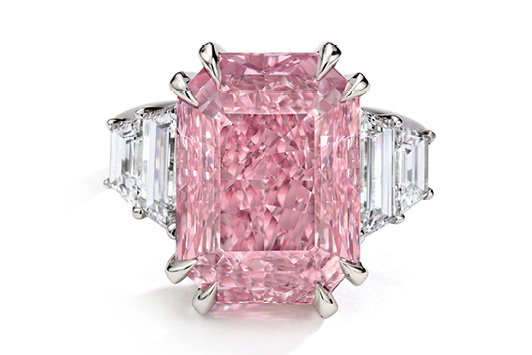
The results of Sotheby’s Hong Kong Magnificent Jewels and Jadeite sale reflected the difficult state of the diamond industry and the political and economic unrest in Hong Kong. Approximately 59% of the 209 lots on offer at the October 7 auction sold, a low percentage by any standard. The items
left on the block ranged from fancy-colored to colorless diamonds, from high-profile gemstones to signed and vintage jewels. Most notably, a number of sapphires, rubies and emeralds failed to secure buyers.
The auction’s approximately $38.3 million total (HKD 300.8 million) was 4.1% lower than the Sotheby’s Hong Kong sale in April and down 4.5% from the October 2018 sale — though this wasn’t as dramatic a drop as one might have expected given the volatile environment in the region and within the industry.
The results were likely buffered by off-site bidding, as fewer people than usual attended the sale personally. Poor attendance at the pre-sale exhibition had led Sotheby’s to expect this and increase the number of phone lines at the auction by 20%, said Kevin Ching, CEO of Sotheby’s Asia. “While we observed a decrease in the number of visitors attending the exhibition, the percentage of phone bidding and online bidding [at the sale] grew by 17% and 44% respectively,” he affirmed.
Ephraim Zion, founder of Hong Kong-based jeweler Dehres, said the business environment was just too difficult at this time for both the municipality and the diamond industry.
“With all the rumors of an economic slowdown and even a threat of recession in Hong Kong, people are very careful. Then, of course, we have our own internal diamond industry drama with the oversupply of rough while demand is very weak. There couldn’t be a worse combination,” said Zion. “You bundle it together, and you have a very weak mix for business.”
A win for Anna Hu
There were certainly high points in the auction. Perhaps the highest of them was a charity sale of five contemporary pieces by jewelry artist Anna Hu. Leading that sale was the Dunhuang Pipa necklace, which featured a 100.02-carat, fancy-intense-yellow diamond that Sotheby’s had provided for the design. It fetched nearly $5.8 million, making it the number-two lot in the auction overall.
The silhouette of the necklace resembles a pipa — a four-stringed Chinese lute — attached to the lines of a Western musical staff in 18-karat white gold and sparkling diamond pavé. It flows in twists and waves, and is transformable into a brooch and an earring.
For Hu, the sale was “a dramatic, amazing, blessed surprise.” Speaking to
Rapaport Magazine, the designer, who was in Paris during the auction, recalled readying herself for the worst: “I mentally prepared myself, [telling myself] that the piece was not the problem and that Sotheby’s was not the problem. It was just bad timing.”
But then a collector appeared an hour before the auction, she later found out, and that person cast the winning bid, a sum that was well within estimates. She doesn’t know the collector’s identity, but the person is familiar to Sotheby’s. The auction house is planning to arrange a meeting between the two.
The necklace was part of Hu’s Silk Road Music collection. A portion of the sale funds from the five-piece line went to Silkroad, a cross-cultural music foundation founded by world-renowned cellist Yo-Yo Ma. The other four pieces fetched $916,119, bringing the total for the collection to nearly $6.7 million.
Rare performance
Another high point was the auction’s top lot: a 10.64-carat, fancy-vivid-purplish-pink, internally flawless diamond that sold for almost $19.9 million. The gem was rare in size, quality and color, according to Sotheby’s.
Zion, whose company specializes in exceptional diamonds and colored gems, said the price for the stone was “reasonable,” although “the color was a little weak.”
While many items from a range of categories failed to sell, several items fetched prices well beyond estimates. In particular, “signed jewels that are unique and rarely available in the market nowadays from brands such as Van Cleef & Arpels, Harry Winston, Graff and Cartier performed well,” reported Lisa Chow, Sotheby’s deputy chairman of jewelry for Asia.
Among the highlights were the Ludo-Hexagone bracelet by Van Cleef & Arpels, which sold for more than double its low estimate at $191,190; a diamond and sapphire Panthère parure by Cartier, which did the same at $672,352; and a Graff diamond clip brooch that shattered its $76,467 high estimate by netting $207,122. Chow also noted the success of “some other attractive gemstones carrying interesting designs...such as melo pearls and aquamarine.”
Image: Sotheby’sArticle from the Rapaport Magazine - December 2019. To subscribe click here.